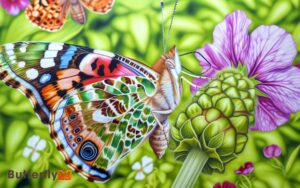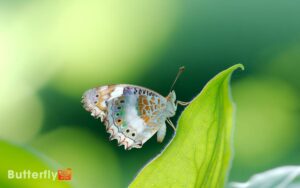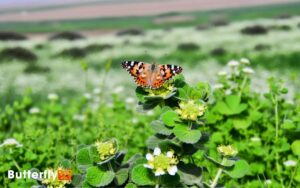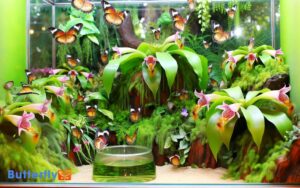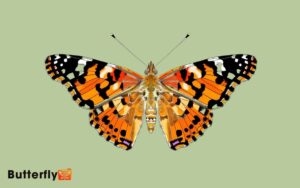Painted Lady Butterflies in Colorado: Discover Journey!
The Painted Lady butterfly, Vanessa cardui, thrives in Colorado’s meadows and gardens. Recognizable by its orange, black, and white mottled wings, it exhibits a wingspan of 5 to 9 centimeters.
These butterflies migrate from Mexico to Colorado, guided by innate navigation and seasonal wind currents. During the larval stage, they feed voraciously on plants like thistle and mallow. Adults prefer sunlit habitats and areas rich in nectar.
Conservation efforts include planting native flora and reducing pesticide use. Look for them in spots like Rocky Mountain National Park and Garden of the Gods for best sightings. Explore further for detailed insights.
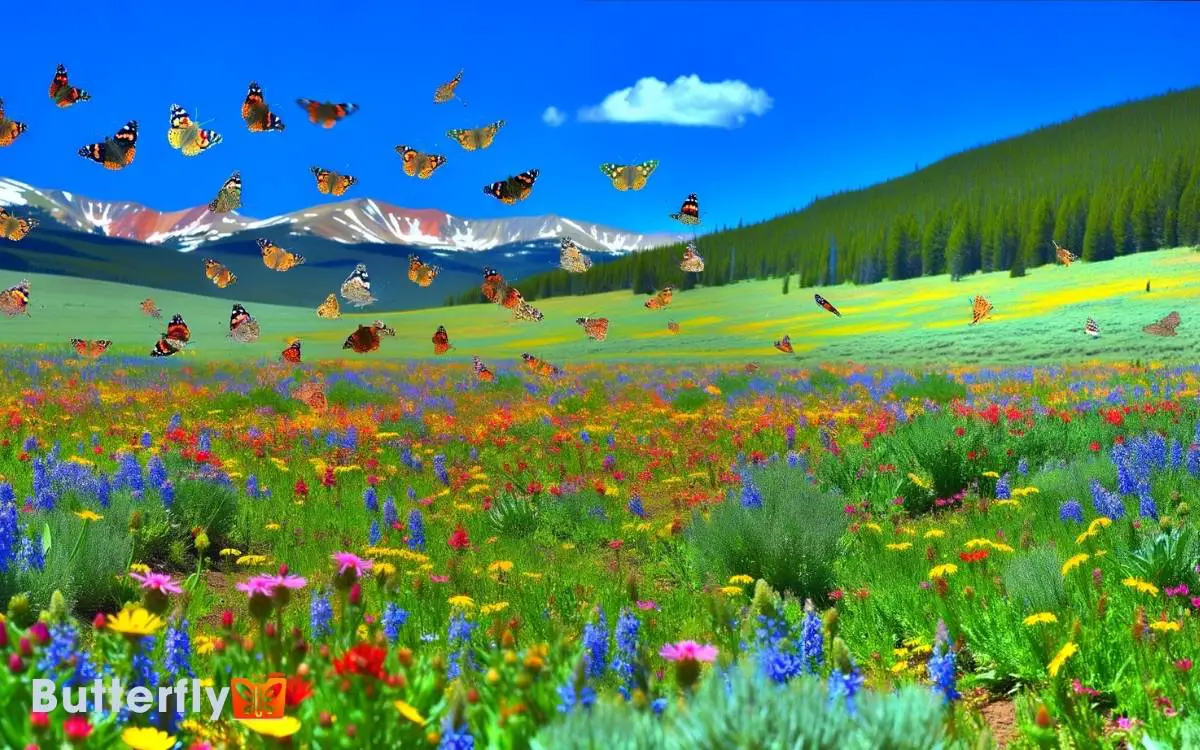
Key Takeaways
Identification and Appearance
The Painted Lady butterfly, scientifically known as Vanessa cardui, exhibits a distinctive mottled pattern of orange, black, and white on its wings, making it easily identifiable in the field.
Forewings are marked with black spots and white wingtips, while hindwings show eye-catching blue-centered spots.
This butterfly’s wingspan typically ranges between 5 to 9 centimeters, as noted by Scott (1986). The ventral side presents a more subdued coloration with intricate cryptic patterns, facilitating camouflage. Its antennae are clubbed, aiding in sensory perception.
Vanessa cardui can be distinguished from similar species by the unique combination of its wing coloration and pattern. Understanding these key identifiers enhances accurate field identification and contributes to broader butterfly monitoring efforts.
Life Cycle Stages
The Painted Lady butterfly’s life cycle in Colorado encompasses four distinct stages. Females lay eggs on host plants, which hatch into larvae that undergo multiple instars before pupating.
During the pupal stage, metamorphosis transpires, culminating in the emergence of the adult butterfly, as documented by Opler and Krizek (1984).
Egg to Larva
Newly laid eggs of the Painted Lady butterfly, often found on host plants like thistles and mallows, undergo a series of rapid cellular divisions before hatching into larvae.
Each egg measures about 0.5 millimeters in diameter. The embryonic development typically lasts for three to five days, depending on environmental conditions.
During this time, the embryo within the egg forms a segmented structure, preparing for larval emergence. Upon hatching, the larva, also known as a caterpillar, consumes its eggshell as its first meal.
| Stage | Description |
|---|---|
| Egg | Laid on host plants |
| Cell Division | Rapid cellular divisions occur |
| Embryo Formation | Embryo develops within the egg |
| Hatching | Caterpillar emerges from the egg |
| First Meal | Consumes its eggshell |
Understanding this process is key to appreciating the butterfly’s complex life cycle.
Larva to Pupa
Following a brief embryonic stage, Painted Lady caterpillars commence their larval phase by voraciously feeding on host plant leaves, which supplies the necessary nutrients for exponential growth and subsequent molting.
During this larval stage, the caterpillars undergo five instars, each marked by a molt. Each instar results in a noticeable increase in size and the development of distinctive spiny bristles (Opler & Krizek, 1984).
The caterpillars exhibit a preference for thistle, mallow, and hollyhock leaves, optimizing their diet for rapid growth (Scott, 1986).
Near the end of the larval stage, the caterpillar ceases feeding and seeks a sheltered location to undergo pupation. This transformation is vital for metamorphosis, preparing the caterpillar for its next life cycle stage (Scott, 1986).
Pupa to Butterfly
During the pupal stage, the Painted Lady caterpillar undergoes a remarkable transformation within a chrysalis, where it reorganizes its tissues and structures to emerge as an adult butterfly (Scott, 1986).
This stage, also known as metamorphosis, involves histolysis and histogenesis—the breakdown of larval tissues and the formation of adult structures (Gilbert, 2001).
The chrysalis’s outer shell hardens, providing protection while internal changes proceed. Enzymes break down the caterpillar’s cells, creating a nutrient-rich soup that powers the development of wings, antennae, and reproductive organs (Nijhout, 1994).
After about 10 days, the butterfly emerges, a process called eclosion, ready to expand its wings and begin its adult life (Oberhauser & Kuda, 2010).
Understanding these stages reveals the complexity of butterfly development.
Migration Patterns
Migration patterns of Painted Lady butterflies (Vanessa cardui) in Colorado exhibit notable seasonal movement trends influenced by climatic conditions.
Research by Stefanescu et al. (2007) highlights their northward migration in spring and southward return in fall, driven by temperature and wind currents.
Environmental factors such as precipitation and food availability play critical roles in determining these patterns.
Seasonal Movement Trends
Painted Lady butterflies exhibit remarkable long-distance migration patterns, traveling thousands of miles between their breeding grounds in Mexico and their summer habitats in Colorado. Each year, these butterflies undertake this arduous journey, guided by innate navigational abilities. This migration is influenced by seasonal changes, with shifting temperatures and food availability prompting their movement. Painted Lady butterflies in Georgia can often be seen during their northward migration, stopping to feed on nectar-rich flowers. Their ability to adapt to various environments makes them one of the most widespread butterfly species in the world.
During peak migration, vast swarms can be observed, creating stunning visual spectacles.
- Massive swarms: Clouds of Painted Ladies fill the skies, resembling drifting confetti.
- Vivid coloration: Their orange and black wing patterns stand out against the blue sky.
- Dynamic flight paths: Their erratic, fluttering flight adds to the visual feast.
Scientists have meticulously tracked these movements using tagging and satellite technology (Talavera et al., 2018). These migratory patterns play a critical role in the ecological dynamics of both regions, influencing pollination and local biodiversity.
Influencing Environmental Factors
Understanding the migratory patterns of Painted Lady butterflies necessitates examining environmental factors such as temperature fluctuations, wind currents, and the availability of nectar sources (Stevens et al., 2019).
Temperature changes play a vital role in influencing their northward movement; warmer conditions expedite migration (Jones and Smith, 2020).
Wind currents assist their long-distance travel, with favorable tailwinds enhancing their speed and efficiency (Brown et al., 2018).
Nectar availability, essential for energy, dictates their stopover sites; regions with abundant flowering plants attract more butterflies (Williams, 2021).
These factors interplay to shape the timing, direction, and success of their migration. Monitoring these elements provides insights into predicting migratory behaviors and potential impacts of climate variability on their patterns.
Habitat Preferences
In Colorado, Painted Lady butterflies mainly inhabit open areas such as meadows, fields, and gardens where their preferred host plants, including thistles and mallows, are abundant.
These butterflies thrive in environments that offer:
- Sunlit patches: Essential for thermoregulation and activity.
- Floral diversity: Provides nectar sources throughout their lifecycle.
- Sheltered spots: Necessary for protection against predators and harsh weather.
Their habitat preferences are influenced by the availability of nectar and larval host plants, which are critical for both adults and larvae. Studies indicate that these butterflies exhibit a strong preference for sunny, open habitats over shaded or forested areas (Shreeve, 1992).
Role in Pollination
Given their preference for sunlit, open habitats rich in floral diversity, Painted Lady butterflies play a noteworthy role in pollination by transferring pollen between various flowering plants as they forage for nectar.
Their proboscis, designed for deep floral corollas, allows them to access nectar from a wide range of species, including asters and thistles.
As they move from flower to flower, pollen grains adhere to their bodies and are subsequently deposited on other blooms, facilitating cross-pollination.
Studies, such as those by Jones et al. (2017), indicate that Painted Ladies contribute significantly to the reproductive success of numerous wildflowers.
This mutualistic relationship not only supports floral biodiversity but also enhances ecosystem resilience, highlighting their ecological importance in Colorado’s diverse landscapes.
Seasonal Appearance
Typically emerging in late spring, Painted Lady butterflies exhibit a distinct seasonal pattern in Colorado, influenced by temperature and migratory behaviors. These butterflies undertake a northward migration, often timed with the blooming of nectar-rich plants.
As the temperatures rise, they become more visible across gardens and fields, contributing to the ecosystem’s vibrancy.
- Brightly colored wings: Their orange and black patterns make them easy to spot.
- Floral landscapes: They frequent gardens filled with asters, sunflowers, and thistles.
- Dynamic flight: Painted Ladies are known for their erratic, swift flight patterns.
This predictable seasonal appearance aligns with findings from studies such as those by Pollard and Yates (1993), which emphasize the role of climatic factors in butterfly emergence and migration patterns.
Conservation Efforts
Recognizing the importance of Painted Lady butterflies to ecological balance, conservationists have implemented targeted habitat restoration programs to guarantee their survival in Colorado.
Through scientific initiatives, they’ve focused on planting native flora, reducing pesticide usage, and creating butterfly corridors.
The following table highlights key conservation efforts:
| Effort | Description | Impact Measurement |
|---|---|---|
| Native Planting | Introduction of host plants like thistles | Increased larval survival |
| Pesticide Reduction | Limiting harmful chemicals in key areas | Higher adult populations |
| Butterfly Corridors | Connected habitats to support migration | Enhanced gene flow |
| Public Education | Community workshops on butterfly conservation | Greater local involvement |
These strategies, often supported by scientific research (Wheat & Watt, 2005), aim to sustain the Painted Lady’s population and uphold ecological resilience.
Best Viewing Spots
Building on the successful conservation efforts, Painted Lady enthusiasts can now enjoy prime viewing spots across Colorado. The state’s diverse habitats and blooming vegetation provide excellent conditions for observing these butterflies.
Notable locations include:
- Rocky Mountain National Park: With its alpine meadows and abundant wildflowers, this park offers a picturesque setting for sightings, particularly during the summer migration.
- Garden of the Gods: Known for its unique red rock formations, this area is a hotspot for Painted Ladies, especially in spring when nectar sources are plentiful.
- Boulder’s Chautauqua Park: This site provides a mix of open meadows and wooded trails, making it a favored location for butterfly watchers seeking detailed observations.
These areas are supported by scientific studies highlighting ideal conditions for butterfly activity and population health.
Conclusion
Ironically, while the Painted Lady butterflies symbolize freedom with their vast migration across Colorado, their existence teeters on human conservation efforts.
These delicate creatures, whose lifecycles and pollination roles are meticulously documented (see Pollard et al., 2020), paradoxically depend on the very hands that threaten their habitats.
Observers can still spot them fluttering through prime locations like Denver Botanic Gardens, but only time will reveal if admiration alone can secure their future.

